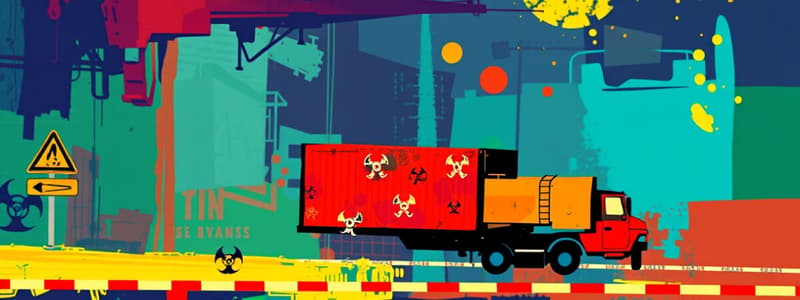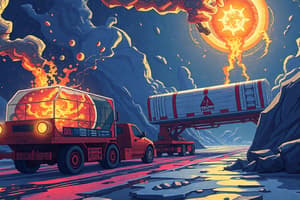Podcast
Questions and Answers
What placards, if any, do you need if your load includes 20 pounds of Division 2.3 gas and 1,001 pounds of flammable gas?
What placards, if any, do you need if your load includes 20 pounds of Division 2.3 gas and 1,001 pounds of flammable gas?
None, you cannot load these materials together.
For Division 1.1 or 1.2 Explosives A, the floor liner required should be stainless steel.
For Division 1.1 or 1.2 Explosives A, the floor liner required should be stainless steel.
False (B)
A hazard class that uses transport indexes to determine the amount that can be loaded in a single vehicle is _____
A hazard class that uses transport indexes to determine the amount that can be loaded in a single vehicle is _____
class 7 radioactive materials
What can best explain the Emergency Response Guide (ERG)?
What can best explain the Emergency Response Guide (ERG)?
It is very important that you never smoke around which hazard classes? (Select all that apply)
It is very important that you never smoke around which hazard classes? (Select all that apply)
There must be a hazardous materials identification number on the ______ and on the ______.
There must be a hazardous materials identification number on the ______ and on the ______.
It is acceptable for non-hazardous materials to be described by hazard class words or identification numbers.
It is acceptable for non-hazardous materials to be described by hazard class words or identification numbers.
How often should you check the tires if your placarded trailer has dual tires?
How often should you check the tires if your placarded trailer has dual tires?
With Division 1.2 or 1.3 Explosive B, how close to the travelled part of the roadway can you park?
With Division 1.2 or 1.3 Explosive B, how close to the travelled part of the roadway can you park?
A portable tank differs from a cargo tank in that ______.
A portable tank differs from a cargo tank in that ______.
Do you need to stop before a railroad crossing if you are hauling 100 pounds of Division 4.3 Dangerous When Wet material?
Do you need to stop before a railroad crossing if you are hauling 100 pounds of Division 4.3 Dangerous When Wet material?
Five hazard classes that require placarding in any amount are ______.
Five hazard classes that require placarding in any amount are ______.
You must keep shipping papers describing hazardous materials ______.
You must keep shipping papers describing hazardous materials ______.
Why do drivers placard their vehicle?
Why do drivers placard their vehicle?
With Division 1.1, 1.2, or 1.3 Class A or B, how close can you park to a bridge, tunnel, or building?
With Division 1.1, 1.2, or 1.3 Class A or B, how close can you park to a bridge, tunnel, or building?
What type of fire extinguisher must placarded vehicles carry?
What type of fire extinguisher must placarded vehicles carry?
What are the three hazard classes that should NOT be loaded into a trailer that has a heater air conditioning unit?
What are the three hazard classes that should NOT be loaded into a trailer that has a heater air conditioning unit?
If your engine runs a pump used during the delivery of compressed gas, when should you turn off the engine?
If your engine runs a pump used during the delivery of compressed gas, when should you turn off the engine?
A safe haven is ______.
A safe haven is ______.
A shipment described on the Hazardous Waste Manifest may only be delivered to another _______ carrier or treatment facility.
A shipment described on the Hazardous Waste Manifest may only be delivered to another _______ carrier or treatment facility.
To decide which placards you need, what three things do you need to know?
To decide which placards you need, what three things do you need to know?
What should you do if you discover your hazardous materials shipment is slowly leaking from the vehicle at a rest area with no phone around?
What should you do if you discover your hazardous materials shipment is slowly leaking from the vehicle at a rest area with no phone around?
Containment Rules tell shippers how to ______.
Containment Rules tell shippers how to ______.
What do shippers need to put on packages to communicate the risks?
What do shippers need to put on packages to communicate the risks?
What does a materials hazard class reflect?
What does a materials hazard class reflect?
What is Class 1?
What is Class 1?
What is Class 2?
What is Class 2?
What is Class 3?
What is Class 3?
What is Class 4?
What is Class 4?
What is Class 5?
What is Class 5?
What is Class 6?
What is Class 6?
What is Class 7?
What is Class 7?
What is Class 8?
What is Class 8?
What is Class 9?
What is Class 9?
What do shipping papers describe?
What do shipping papers describe?
What are the rules about shipping papers?
What are the rules about shipping papers?
Where must drivers keep hazardous materials shipping papers?
Where must drivers keep hazardous materials shipping papers?
What shape are packaging labels?
What shape are packaging labels?
Where do you put a packaging label?
Where do you put a packaging label?
What are placards?
What are placards?
How many placards must a vehicle have?
How many placards must a vehicle have?
Where are the placards put on the vehicle?
Where are the placards put on the vehicle?
What are identification numbers?
What are identification numbers?
Hazardous Materials Table: Column 1 tells which _______.
Hazardous Materials Table: Column 1 tells which _______.
Column 2 lists the _______.
Column 2 lists the _______.
Column 3 shows a material's _______.
Column 3 shows a material's _______.
Column 4 lists the _______.
Column 4 lists the _______.
Column 5 shows the _______.
Column 5 shows the _______.
Column 6 shows the _______.
Column 6 shows the _______.
Column 7 lists the _______.
Column 7 lists the _______.
Column 8 shows the section numbers covering the _______.
Column 8 shows the section numbers covering the _______.
What must the shipping papers include?
What must the shipping papers include?
What is the item description on shipping paper if it describes both hazardous and non-hazardous products?
What is the item description on shipping paper if it describes both hazardous and non-hazardous products?
What are package markings and labels?
What are package markings and labels?
What is a Hazardous Waste Manifest?
What is a Hazardous Waste Manifest?
Can you remove an improperly placed placard?
Can you remove an improperly placed placard?
What are must-know facts about placards?
What are must-know facts about placards?
What does Placard Table 1 indicate?
What does Placard Table 1 indicate?
What does Placard Table 2 indicate?
What does Placard Table 2 indicate?
What are General Loading Requirements?
What are General Loading Requirements?
What are the rules for smoking when loading or unloading hazardous materials?
What are the rules for smoking when loading or unloading hazardous materials?
Flashcards are hidden until you start studying
Study Notes
Hazardous Materials Overview
- Division 2.3 gases and flammable gases cannot be loaded together.
- Floor liners are not required to be stainless steel for Division 1.1 or 1.2 Explosives A.
Hazard Classifications
- Class 7 includes radioactive materials using transport indexes for vehicle loading.
- Five hazard classes requiring placarding in any amount: Poison Gas (2.3), Dangerous When Wet (4.3), Explosives (1.1, 1.2, 1.3).
Emergency Response and Safety
- The Emergency Response Guide (ERG) serves as a safety reference for various emergency responders and shippers.
- Smoking is prohibited around explosives, flammable gases, solids, and liquids.
Shipping Regulations
- Hazardous materials identification numbers must appear on shipping papers and packages.
- Non-hazardous materials must never be described by hazard class words or identification numbers.
- Shipping documents must accurately describe hazardous materials, including packaging instructions.
Vehicle and Loading Guidelines
- Tires on placarded trailers should be checked every 2 hours or after 100 miles.
- Vehicles carrying Division 1.2 or 1.3 Explosives B must park at least 5 feet away from roadways.
- Do not park within 300 feet of bridges, tunnels, or buildings when transporting Explosive Class A or B.
Packaging and Marking
- A portable tank is distinct from a cargo tank in that it is not permanently attached to the vehicle.
- Shipping papers containing hazardous materials must be readily accessible to drivers, stored in a pouch or in view.
Placarding Requirements
- Vehicles require four identical placards for hazardous materials, placed on the front, rear, and both sides.
- Identification numbers (4-digit codes) help first responders quickly understand the materials being transported.
Hazard Classes Specifics
- Class 1 includes various types of explosives, while Class 2 covers flammable and poisonous gases.
- Class 3 pertains to flammable liquids, Class 4 indicates flammable solids and spontaneously combustible materials.
- Class 8 denotes corrosive materials, and Class 9 includes miscellaneous hazardous materials.
Hazardous Waste Management
- Shipments of hazardous waste require proper manifests that must be signed and dated by shippers and carriers.
- Waste should only be transferred to registered disposal or treatment facilities.
Additional Guidelines
- Packaging labels are typically diamond-shaped, and if they don’t fit, a tag must be securely attached.
- Maintenance of cleanliness and visibility of placards is crucial for effective hazard communication.
General Safety Practices
- Drivers must be aware of conditions leading to leaks and not move leaking vehicles to avoid danger.
- Implement safety measures such as securing packages and bracing hazardous materials in vehicles during transport.
Studying That Suits You
Use AI to generate personalized quizzes and flashcards to suit your learning preferences.



